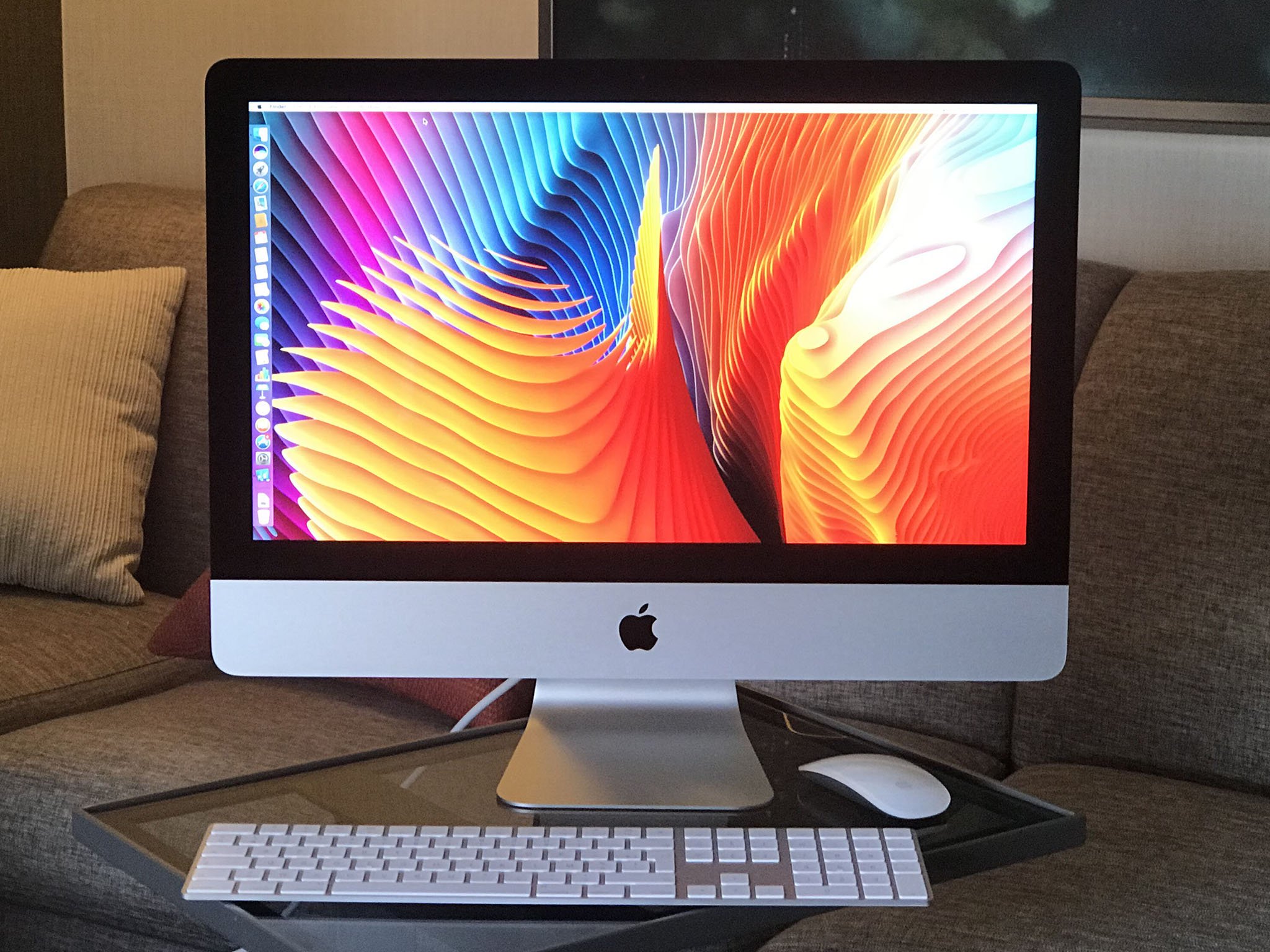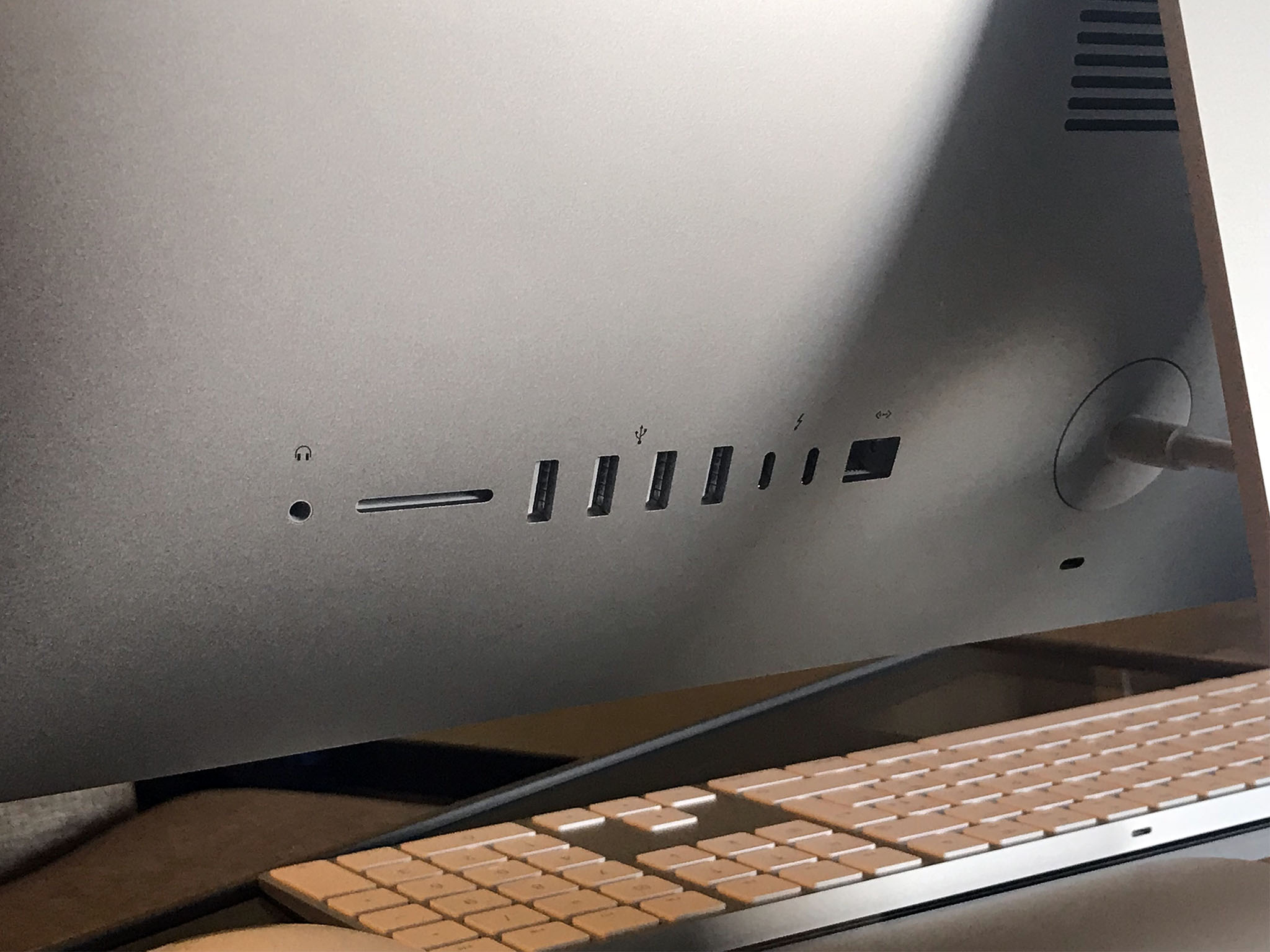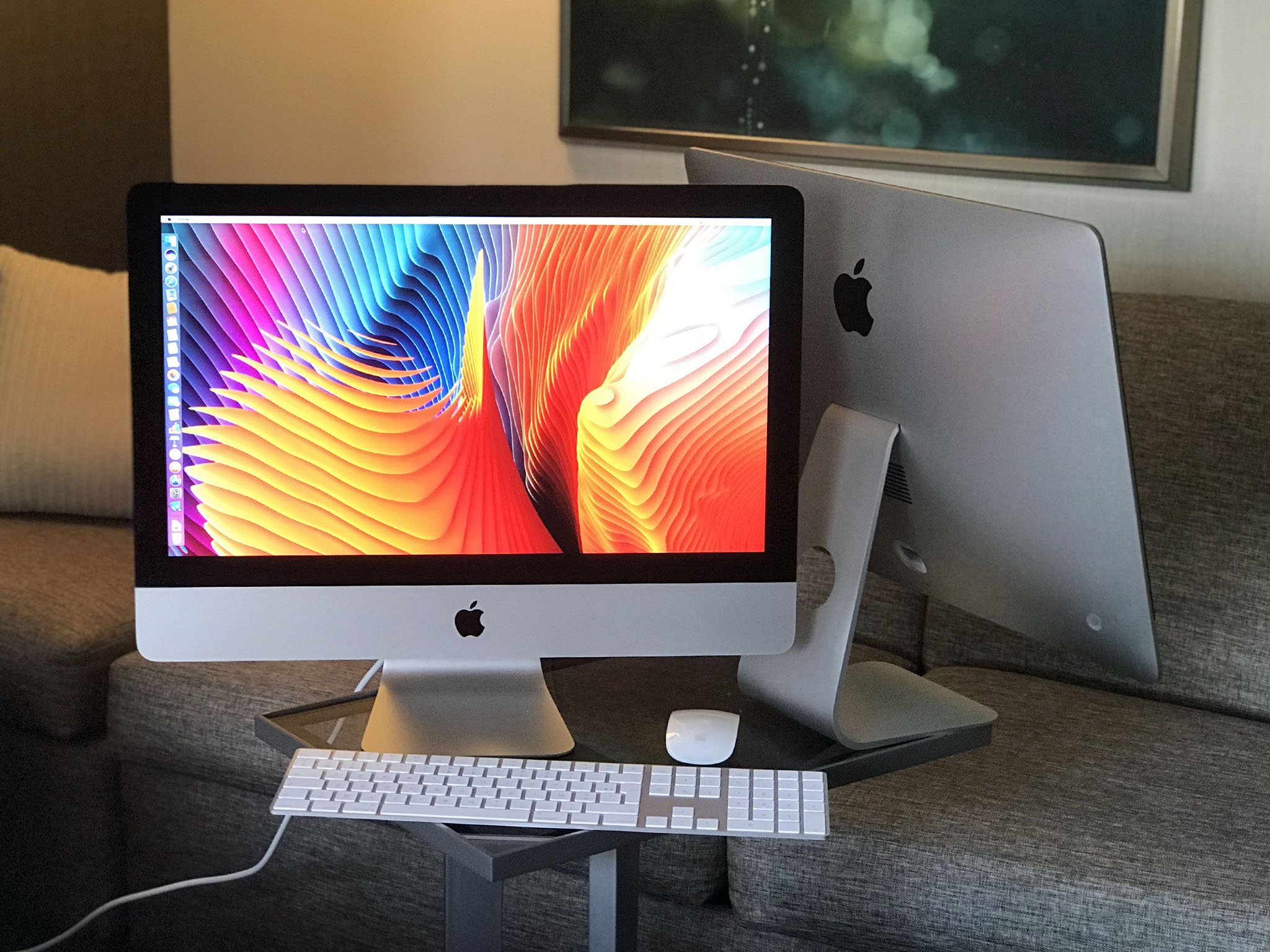Three years ago Apple introduced the 5K iMac with Retina display. Two years ago Apple introduced the smaller 4K iMac with Retina display and gave both DCI-P3 wide color. Now Apple is taking those displays, and the iMac in general, to the next level.
In some ways, it's analogous to how macOS High Sierra refines the Sierra experience. These are all iMacs, all mature products, and the overall experience of using them is exactly what you'd expect. Only better.
The displays are the same size, density, and depth, but even brighter and more colorful. The graphics card is faster. Intel finally got its Kaby Lake act together, so iMac is now on the 7th-generation Core-series processor. Memory can go higher. Storage is going faster. Ports now include USB-C / Thunderbolt 3. And even the Magic Keyboard can have a little more magic if you like — an extended numeric keypad.
All of it still bound in the same razor-thin aluminum and glass enclosure, starting at $1099 for 1080p, and $1299 for Retina 4K.
About this review

Imagine you get called to Lamborghini, told there's a new edition of your beloved hypercar coming out, and that you have 12 hours to drive it and write it up. Now imagine that but with new iMacs.
Circumstances don't let you test the machine over time, but do force you to use every ounce of experience and insight you've earned over the last decade, testing and writing about and Apple products day in, day out, to push it as fast and as hard as you can and see what you learn.
iMore offers spot-on advice and guidance from our team of experts, with decades of Apple device experience to lean on. Learn more with iMore!
Since Apple not only announced the new iMacs but announced that they were immediately available for sale, it's my job to do whatever I can to give you the best buying advice I can as fast as I can.
Here it is.
For people who want:
- The best damn display in the business.
- Ridiculously fast storage options.
- USB-C / Thunderbolt 3 ports
- All-in-one design.
Not for people who want:
- Nvidia graphics.
- Touch screen.
- Touch Bar and Touch ID.
- Modular, tower-style enclosure.
In brief
In an age where the vast majority of people buy laptops, desktop computers have to make stronger and even more compelling reasons to remain relevant. For iMac, that begins and largely ends with the display. Sure, you can get graphics and memory configurations beyond anything currently available on MacBook Pro, but it's that big, beautiful, Apple-branded display that still has many of us at "Hello". And this year it's brighter and more colorful than ever.
Kaby Lake offers fine improvements, even in the age where power efficiency has eclipsed performance, and the Radeon graphics cards are so new I think Apple might have said more about them than AMD at this point. Add to that the flexibility of USB-C and Thunderbolt 3, and the ability to run macOS, Unix/Linux, and Windows, and you once again have the absolute best all-in-one on the market.
At least, until iMac Pro ships. 😎
That display though
It often seems like iMac begins and ends with that display. At 21.5 inches for the 1080p and 4K and 27 inches for the 5K, it's easy to see why: It's so big, so lush, and so engrossing that everything else disappears. It's almost surreal.

When I first saw Retina on iMac, I thought it almost looked better than real life. Then, when I saw DCI-P3 Retina, I was fairly sure it looked better. Now that it's 43% brighter — 500 nits if you're keeping score — and implements 10-bit dithering for a billion colors, I'm convinced. It doesn't just look true to life. It looks truer to life.
DCI-P3 really helped out with the reds and greens. But in some ways it was a mixed blessing: If your image was bad, you could really see it was bad.
Now, 10-bit dithering makes sure all those reds, greens, and every color around and in between transitions smoothly and with no unsightly banding or stepping. The way it works is that 10-bit color information is sent to the TCON (Apple's custom timing controller), which then dithers it specially and temporally for display on the 8-bit panel. So, even if your image is bad, it looks as good as it possibly can.
There's still no multitouch on the screen, of course. Microsoft might have made a similar-looking Surface Studio that folds down into a giant touch canvas, but Apple is sticking to its story that Macs are ergonomically ill-suited for touch, and macOS is optimized for a mouse and pointer, not a finger.
Since I grew up using mouse-and-pointer computers, I never find myself reaching to touch my iMac display. Kids who grew up using iPads might, though. Considering Apple already has an extremely popular touch-first computing platform with iOS and iPad Pro, it makes little sense to expend the engineering resources to retrofit touch displays onto the Mac. Especially given how good the force touch trackpads are.
Still, I wonder if enabling just touch navigation on Mac displays would be a convenient way forward. Especially for iMacs used in public settings and as kiosks. Swipe, pinch, poke would likely cover 80% or more of common touch use cases, and without the pain Microsoft experienced through Windows 8.
Then, if Apple wanted to do a full touch 27-inch device, I'm sure many graphic artists and illustrators wouldn't mind an even larger iPad Pro.
As it is, for everything from photo and video editing to podcasting to basic daily productivity, iMac works exactly how I expect a traditional computer to work.
The new graphics normal
The 1080p version of the 21.5-inch iMac comes with Intel Iris Plus Graphics 640. Once you step up to the 4K version, though, you immediately get discreet graphics: Radeon Pro 555 with Polaris architecture and 2GB of video memory. You can build-to-order (BTO) that up to Radeon Pro 560 with 4GB video memory and, for the 27-inch, 5K model, Radeon Pro 580 with 8GB video memory.
It's enough of a boost, even comparing these models to the last ones, that if you were hitting the performance ceiling before, you'll now have some room to breathe. Or just room to do even more and hit the higher ceiling.
That includes, of course, editing in Final Cut Pro X, rendering 3D, and even gaming. On average, I'm expecting up to a 2x improvement. I'm seeing just under that for video right now, but Apple says gaming and 3D are at least that, if not more.
The bigger news, at least for me, is Metal 2. Apple already flattened OpenGL down to a much faster framework a couple years ago. Now it's redoubling that performance. Literally. It's enough to enable virtual reality (VR) on the Mac.
I got to try out the Final Cut Pro X demo using an HTC Vive headset and it was striking. Apple's focusing first and foremost on VR content creation, but existing VR content should start appearing in time.
It remains to be seen if the Mac gets the big VR games, like the recently released Star Trek Bridge Crew, and how they'll perform. But I hope it does and they do well. I don't want to maintain a separate PC or have to navigate Windows 10 just to game in VR. With Metal 2 and the also just-announced eGPU options coming later, the future is looking promising.
Kaby Lake: The desktop story
Kaby Lake Macs are here. "Finally". I snark-quoted that because Apple's very polite when it comes to explaining why Kaby Lake Macs were so long in coming. The company simply says they're here now and hope the recent updates speak to Apple's dedication to the Mac as a platform.
Anyone who's been watching, though, knows the longer gaps between some of the more popular Macs aren't just because of Apple. They're at least partially because of Intel.
Apple can't ship a computer with a chipset that doesn't exist. Two years ago, Apple couldn't even bump the 21.5-inch iMac because Intel hadn't made an updated version of the chip Apple used for that machine. Last year, some Kaby Lake chips shipped but not all of them, including the 4-core versions and versions with the graphics options Apple wants for iMac.
It affects features too. iMacs used to support target display mode so they could be used as a monitor for other Macs. Now they don't. That's because Intel kept delaying the integration of 5K-capable DisplayPort — and continues to delay it — and so Apple had to make 5K work without Intel and, in so doing, had to sacrifice Target Display mode.
Those architectural realities created debt we're still all paying. Flash forward two and a half years later and we still don't have target display port back.
But now, Kaby Lake Macs are here.
So, what does that mean for iMac? It's a good question, since recent processor generations have been more about power efficiency than power. Kaby Lake does increase both the baseline and turbo frequencies for the Mac, so you can go a bit faster.
If benchmarks are your thing, Geekbench put my entry-level 1080p iMac review unit at 4,595 for single core, 9,531 for multi-core, and 28,216 for OpenCL. My maxed-out 4K iMac review unit at 4,865 for single core, 14,111 for multi-core, and 55,885 for OpenCL.
Power efficiency also helps, even on a desktop. A big part of the reason is the new, built-in hardware acceleration for H.265 (which I still have a hard time calling by its marketing name, HEVC). The successor to H.264, it allows for much more efficient video playback, including 4K video.
On a MacBook, that translates to longer battery life. On an iMac, though, it translates into lower processor overhead. So instead of your 4K software-decoded video pegging the CPU and slowing down everything else you're doing, it just hums along and lets you do all sorts of other tasks at the same time.
The 21.5-inch model comes with a 2.3GHz dual-core Intel Core i5 processor with Turbo Boost up to 3.6GHz. The maxed-out 21.5-inch model comes, BTO, with a 3.6GHz quad-core Intel Core i7, Turbo Boost up to 4.2GHz. The maxed out 27-inch, BTO, a 4.2GHz quad-core Intel Core i7, Turbo Boost up to 4.5GHz.
If you already have Skylake, you'll have to weigh the differences in processing and graphics power to see if the upgrade make sense for you. If you have Broadwell or earlier, though, it's compelling.
More than just speed deep
Beyond the processor, Apple's also switched iMac to DDR4 memory, and you can stuff up to 32GB in the 21.5-inch models and up to 64GB in 27-inch models.
Fusion Drive is now standard on all higher-end 21.5-inch iMacs, and all 27-inch iMacs. Once I went SSD, though, I couldn't go back. Fusion Drive is a good compromise for those who want fast initial storage but are ok with bigger, if slower, second-stage storage. But I want it all blazingly fast, all the time. And I'll hang platters off the USB or TB ports for backups and larger volume storage.
That's why I'm particularly thrilled Apple's made SSD 50% faster in iMac now as well. And you can max it out at 2TB,
Ports, only faster
In addition to the hold-over 3.5 mm headphone jack, SDXC card reader, 4x USB-A, and Ethernet ports, iMac now gets two of the USB-C /Thunderbolt 3 ports that debuted on the new MacBook Pro.

They support DisplayPort, Thunderbolt up to 40Gbps, USB 3.1 (up to 10 Gbps) and, with adapters, can handle Thunderbolt 2, HDMI, DVI, and VGA as well.
SDXC is the thing I've missed most from the new MacBook Pro so, I'm thrilled Apple's kept it on iMac. Otherwise, I'm all in on USB-C / TB 3. Sure, the USB consortium may change standards again in the future, but until they do, these are forward-thinking ports that'll enable everything from 5K displays to eGPU for a long time to come.
Keyboard, only extended
I've never liked numerical keyboards. They got in the way of where I wanted my trackpad to be. I was happy when I thought Apple had killed them. But my use case isn't everyone's use case, so, much less selfishly, I'm even happier they're back.

Enjoy, spread-sheeters!
Of course, I would have been even happier had Apple introduced a Touch Bar- and Touch ID-equipped version of the Magic Keyboard. Having sometimes arcane keyboard shortcuts and buried controls surfaced right atop the keyboard is convenient, but fingerprint login and authentication are becoming must-haves for me.
Since the iMac keyboard is a separate bit of electronics, conceivably it could be updated again with the touch twins at any time. I'm just hoping that's sooner rather than later.
Welcome to 2017, iMac!
I had the opportunity to spend some extra time with the new entry-level iMac. At $1099 for 1080p and a traditional, 5400 rpm hard drive, it feels like the MacBook Air of iMacs. Again, if you've already gone Retina, discreet graphics, and SSD like me, you can't go back.
With the 4K iMac starting at just $1299, that'd be my instant, emphatic recommendation for anyone who has the extra 200 bucks to spend.
If you're buying in volume, if you're looking for a kiosk, or if you're considering a Mac mini for a student but really want an all-in-one, or you simply need the lowest price possible for an iMac, the 1080p is better than it was before. Noticeably.
If you can find the extra money, though, the 4K is beyond worth it. The 5K, even more so. Combined, they make 2017 a solid year with solid upgrades to all the components that matter most — the ones that make iMac such an enthralling, compelling desktop experience.
And we haven't even gotten to iMac Pro yet!

○ Everything about WWDC 2020
○ WWDC 2020 remote lineup
○ Download the Apple Developer app
○ iOS/iPadOS 14
○ macOS 10.16
○ watchOS 7
○ tvOS 14
○ Discussion forums

Rene Ritchie is one of the most respected Apple analysts in the business, reaching a combined audience of over 40 million readers a month. His YouTube channel, Vector, has over 90 thousand subscribers and 14 million views and his podcasts, including Debug, have been downloaded over 20 million times. He also regularly co-hosts MacBreak Weekly for the TWiT network and co-hosted CES Live! and Talk Mobile. Based in Montreal, Rene is a former director of product marketing, web developer, and graphic designer. He's authored several books and appeared on numerous television and radio segments to discuss Apple and the technology industry. When not working, he likes to cook, grapple, and spend time with his friends and family.

